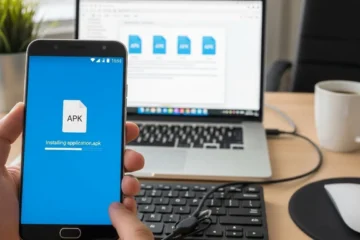Virtual reality has changed the way we play games, watch videos, and even work. One of the most popular VR headsets that made this possible was the Oculus Quest 1, released in 2019.
It was special because it was the first standalone headset that didn’t need a PC or console to run VR experiences. Even today, many people still use the Quest 1 because it’s wireless, simple to set up, and has a wide library of apps.
But owners of the Quest 1 often wonder:
“Can I get any APK and sideload it on my Quest 1?”
The short answer is yes—you can sideload APKs on the Quest 1. However, the long answer is a bit more complex.
You need to understand how APKs work, what sideloading actually means, how to do it properly, and the possible risks.
This detailed guide will cover everything you need to know.
Understanding APK Files
An APK (Android Package Kit) is the standard format used by Android devices to install applications.
Every app you download from the Google Play Store is technically an APK, but the store installs it for you automatically in the background.
Some key points about APKs:
- They contain all the data, code, and resources required for an app to run.
- APKs can be downloaded directly from websites, forums, or shared by developers.
- Not all APKs are official or verified, which is why you must be careful when downloading them.
Since the Oculus Quest 1 runs on a version of the Android operating system, it is technically capable of installing APK files just like a phone.
That means apps not available in the Oculus Store can still be installed and used.
What Is Sideloading?
Sideloading is the process of manually installing APKs instead of downloading them through the official Oculus Store.
In simple terms, it’s like installing a program on your PC using a setup file instead of downloading it from the Microsoft Store.
For VR users, sideloading is very popular because:
- Many VR developers create experimental apps that don’t meet Oculus Store requirements.
- Independent creators release apps and games that are not officially published.
- Some tools, emulators, and mods exist only as APKs.
By sideloading, you unlock a much bigger library of apps than what Meta officially provides.
Is It Safe and Legal?
This is one of the most common concerns.
- Legality: Sideloading is legal. Meta even provides a way for developers to install their own APKs for testing.
- Piracy: Downloading paid apps for free from illegal sources is not legal and can lead to account suspension.
- Safety: APKs from random websites may contain malware or viruses. For example, if you download from an unknown site, you might end up with spyware instead of a game.
The best way to stay safe is to only use trusted sources like SideQuest, Itch.io, GitHub, or the official website of a developer.
Can You Really Sideload “Any” APK?
Here’s the important part: while you can try to install any APK file, not all of them will actually work on your Quest 1.
1. Hardware Compatibility
Quest 1 uses the Snapdragon 835 processor. This chip is powerful enough for many VR experiences, but it is older compared to modern smartphones or newer headsets. If an app requires stronger hardware (like Quest 2 or Quest 3), it may run very slowly or not run at all.
2. Software Requirements
Some APKs require services or features only found on smartphones. For example, a mobile banking app APK will install, but it won’t function properly in VR.
3. VR Support
The most important factor is whether the APK is VR-compatible. Many standard Android apps are designed for touchscreen use, not VR controllers. They might run as a flat 2D screen floating in your virtual environment, which is not useful.
So while you technically can sideload “any” APK, only apps built for VR or adapted to VR will give you the experience you want.
Step-By-Step Guide to Sideloading APKs on Oculus Quest 1
Let’s go through the process in detail.
Step 1: Enable Developer Mode
Meta requires Developer Mode to be turned on before sideloading.
- Install the Meta (Oculus) app on your smartphone.
- Connect your Quest 1 to the app.
- In the app, go to Devices → Developer Mode.
- Toggle it on.
- If Developer Mode isn’t available, you’ll need to sign up as a developer on Meta’s website. It’s free and only takes a few minutes.
Step 2: Install SideQuest
SideQuest is the most popular and beginner-friendly platform for sideloading apps.
- Download it from: https://sidequestvr.com/
- Install it on your computer (Windows, Mac, or Linux).
SideQuest provides access to thousands of apps and also acts as an easy installer for APKs.
Step 3: Connect Your Quest
- Use a USB cable to connect your Quest 1 to your computer.
- Put on the headset and approve any popups for “USB Debugging.”
- Once connected, SideQuest will recognize your device.
Step 4: Install APKs
- Browse the SideQuest library and install apps directly by clicking “Install to Headset.”
- If you already have an APK file downloaded, you can drag and drop it into the SideQuest window to install it.
Where to Find Reliable APKs?
Some recommended sources include:
- SideQuest – Officially the best place for VR apps. Everything is tested and safe.
- Itch.io – Indie developers often release unique VR games here.
- GitHub – For open-source VR projects. Great if you want experimental tools.
- Official Developer Websites – Some apps are released directly by creators.
Always double-check before downloading from anywhere else.
Types of Apps You Can Sideload
Here are categories of apps people commonly sideload on Quest 1:
- VR Games: Many early-access or beta games are distributed this way.
- Emulators: Play classic games like Nintendo or PlayStation titles in VR.
- Media Players: Advanced video players with features not found in the Oculus Store.
- Productivity Tools: File browsers, web utilities, or even note-taking apps.
- VR Mods: Customizations for existing games like Beat Saber.
Advantages of Sideloading on Quest 1
- Access More Apps: Go beyond the official Oculus Store.
- Support Indie Developers: Many small studios share their work through SideQuest.
- Experimentation: Try apps that are still in development.
- Extend Device Life: Even though Quest 1 is older, sideloading keeps it useful.
Risks of Sideloading
While sideloading is powerful, it does come with risks.
- Security Risks: APKs from unknown websites can contain harmful code.
- Performance Issues: Some apps may crash or perform poorly on Quest 1 hardware.
- VR Incompatibility: Not every APK is designed for VR use.
- Legal Issues: Downloading pirated games is illegal and unsafe.
Tips For Safe and Effective Sideloading
- Use only trusted platforms like SideQuest.
- Read user reviews before installing an app.
- Keep your Quest firmware up to date.
- Don’t overload your headset with too many experimental apps—it can slow down performance.
- Backup your data if you plan to test unstable apps.
The Future of Sideloading on Quest 1
The Quest 1 no longer receives major updates from Meta, but the VR community still supports it. Sideloading ensures that:
- Indie VR games remain available.
- Classic emulators and tools keep working.
- Users can extend the life of their headset instead of upgrading.
Even as newer models like Quest 2, Quest Pro, and Quest 3 take the spotlight, sideloading makes sure Quest 1 users are not left behind.
Final Thoughts
So, can you get any APK and sideload it on Quest 1?
Yes, you can sideload almost any APK, but only those designed for VR or compatible with Quest 1’s hardware will actually provide a good experience. Installing a mobile APK meant for a phone might work, but it won’t be practical in VR.
If you sideload responsibly—using SideQuest, trusted developers, and avoiding pirated apps—you can safely expand your VR library and enjoy your Quest 1 for years to come.
Sideloading is one of the best ways to unlock the full potential of the Oculus Quest 1, even as newer headsets take over the market.




